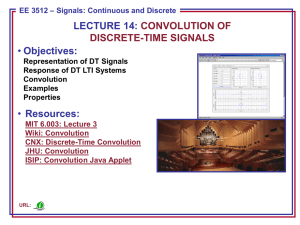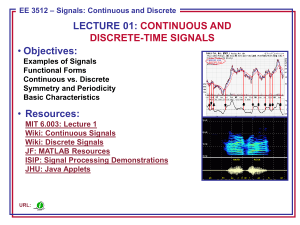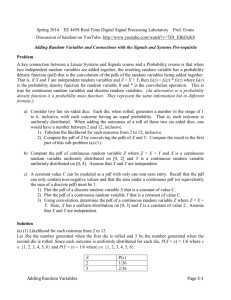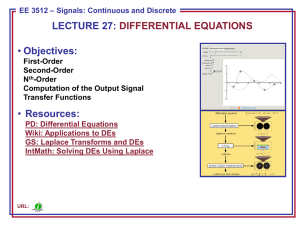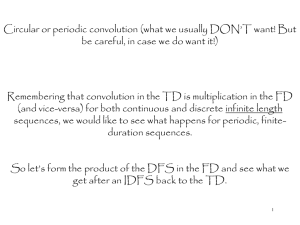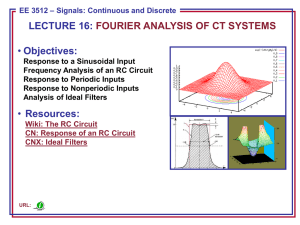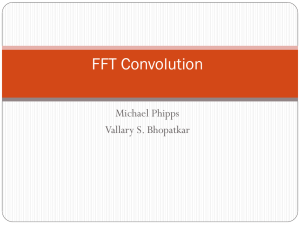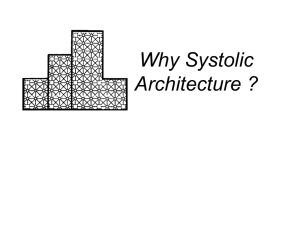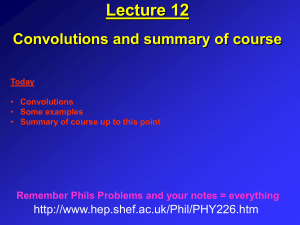lecture_15
advertisement
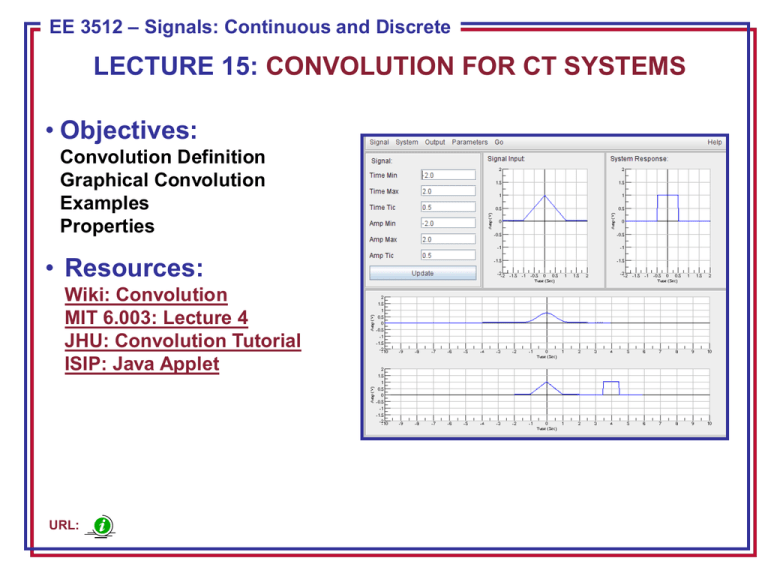
ECE 8443 – PatternContinuous Recognition EE 3512 – Signals: and Discrete LECTURE 15: CONVOLUTION FOR CT SYSTEMS • Objectives: Convolution Definition Graphical Convolution Examples Properties • Resources: Wiki: Convolution MIT 6.003: Lecture 4 JHU: Convolution Tutorial ISIP: Java Applet URL: Representation of CT Signals • Recall from calculus how we approximated a function by a sum of timeshifted, scaled pulse functions: • We approximate the signal’s amplitude value as a constant over the interval k t (k 1) : xˆ (t ) x(k) for k t (k 1) • The signal changes discontinuously at the next step. • What happens as 0 ? Recall our representation of a CT impulse function: EE 3512: Lecture 15, Slide 1 Representation of CT Signals Using Impulse Functions • We approximate a CT signal as a weighted pulse function. • The signal can be written as a sum of these pulses: xˆ (t ) x(k) k (t k) • In the limit, as 0 : x(t ) x( ) (t )d • Mathematical definition of an impulse function (the equivalent of the unit pulse for DT signals and systems): 0 (t ) for t 0 for t 0 0 (t )dt 1 0 • Unit pulses can be constructed from many functional shapes (e.g., triangular or Gaussian) as long as they have a vanishingly small width. The rectangular pulse is popular because it is easy to integrate EE 3512: Lecture 15, Slide 2 Response of a CT LTI System x(t ) CT LTI h(t ) y(t ) x(t ) * h(t ) • Denote the system impulse response, h(t), as the output produced when the input is a unit impulse function, (t). • From time-invariance: (t ) h(t ) • From linearity: x(t ) x( ) (t )d y(t ) x( )h(t )d x(t ) * h(t ) • This is referred to as the convolution integral for CT signals and systems. • Its computation is completely analogous to the DT version: EE 3512: Lecture 15, Slide 3 Example: Unit Pulse Functions • t < 0: y(t) = 0 • t > 2: y(t) = 0 • 0 t 1: y(t) = t • 1 t 2: y(t) = 2-t EE 3512: Lecture 15, Slide 4 Example: Negative Unit Pulse • t < 0.5: y(t) = 0 • t > 2.5: y(t) = 0 • 0.5 t 1.5: y(t) = 0.5-t • 1 t 2: y(t) = -2.5+t EE 3512: Lecture 15, Slide 5 Example: Combination Pulse • p(t) = 1 0 t 1 • x(t) = p(t) - p(t-1) • y(t) = ??? EE 3512: Lecture 15, Slide 6 Example: Unit Ramp • p(t) = 1 0 t 1 • x(t) = r(t) p(t) • y(t) = ??? EE 3512: Lecture 15, Slide 7 Properties of Convolution • Sifting Property: x(t ) * (t t 0 ) x(t t 0 ) Proof: x(t ) * (t t 0 ) x( ) (t t 0 )d t t0 x( ) (t t 0 )d x(t t 0 ) t t0 • Integration: t x( )d x(t ) * u(t ) Proof: t x(t ) * u(t ) x( )u(t )d x( )d because u(t ) 0 for t • Step Response (follows from the integration property): t u(t ) * h(t ) h(t ) * u(t ) h( )d Comments: Requires proof of the commutative property. In practice, measuring the step response of a system is much easier than measuring the impulse response directly. How can we obtain the impulse response from the step response? EE 3512: Lecture 15, Slide 8 Properties of Convolution (Cont.) • Implications (from DT lecture): • Commutative Property: x(t ) * h(t ) h(t ) * x(t ) Proof: x(t ) * h(t ) x( )h(t )d let t , or t , and d d x(t ) * h(t ) x(t )h( )(d ) h( ) x(t )d h(t ) * x(t ) • Distributive Property: x(t ) * [h1 (t ) h2 (t )] x(t ) * h1 (t ) x(t ) * h2 (t ) Proof: x(t ) * [h1 (t ) h2 (t )] x( )[h (t ) h (t )]d 1 2 x( )h1 (t )d x( )h (t )d 2 x(t ) * h1 (t ) x(t ) * h2 (t ) EE 3512: Lecture 15, Slide 9 Properties of Convolution (Cont.) • Implications (from DT lecture): • Associative Property: x(t ) * h1 (t ) * h2 (t ) ( x(t ) * h1 (t )) * h2 (t ) ( x(t ) * h2 (t )) * h1 (t ) Proof: [ x(t ) * h1 (t )] x( )h (t )d 1 [ x(t ) * h1 (t )] * h2 (t ) [ x( )h ( )d ]h (t )d 1 2 x( ) h ( )h (t )dd 1 2 Let and d d x( ) h1 ( )h2 (t ( ))d d x( ) h1 ( )h2 ((t ) )d d x(t ) * [h1 (t ) * h2 (t )] EE 3512: Lecture 15, Slide 10 Useful Properties of CT LTI Systems • Causality: ht 0 n0 which implies: This means y(t) only depends on x( < t). t x( )ht d x( )ht d • Stability: h(t ) Bounded Input ↔ Bounded Output Sufficient Condition: for x(t ) xmax y (t ) x( )ht d xmax ht d Necessary Condition: if ht Let x(t ) h * (t ) / h(t ) , then x(t ) 1 (bounded) h * ( ) But y(0) x( )h0 d h0 d h0 d h( ) EE 3512: Lecture 15, Slide 11 Summary • We introduced CT convolution. • We worked some analytic examples. • We also demonstrated graphical convolution. • We discussed some general properties of convolution. • We also discussed constraints on the impulse response for bounded input / bounded output (stability). EE 3512: Lecture 15, Slide 12
